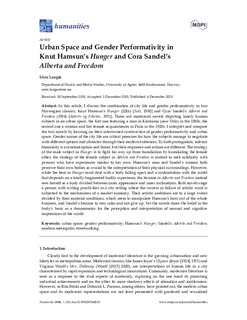| dc.contributor.author | Langås, Unni | |
| dc.date.accessioned | 2018-12-12T09:55:44Z | |
| dc.date.available | 2018-12-12T09:55:44Z | |
| dc.date.created | 2018-12-05T07:00:07Z | |
| dc.date.issued | 2018 | |
| dc.identifier.citation | Humanities. 2018, 7 (4), . | nb_NO |
| dc.identifier.issn | 2076-0787 | |
| dc.identifier.uri | http://hdl.handle.net/11250/2577322 | |
| dc.description.abstract | Abstract: In this article, I discuss the combination of city life and gender performativity in two Norwegian classics, Knut Hamsun’s Hunger (2016) [Sult, 1890] and Cora Sandel’s Alberta and Freedom (1984) [Alberte og friheten, 1931]. These are modernist novels depicting lonely human subjects in an urban space, the first one featuring a man in Kristiania (now Oslo) in the 1880s, the second one a woman and her female acquaintances in Paris in the 1920s. I interpret and compare the two novels by focusing on their intertwined construction of gender performativity and urban space. Gender norms of the city life are critical premises for how the subjects manage to negotiate with different options and obstacles through their modern existences. To both protagonists, inferior femininity is a constant option and threat, but their responses and actions are different. The strategy of the male subject in Hunger is to fight his way up from humiliation by humiliating the female other; the strategy of the female subject in Alberta and Freedom is instead to seek solidarity with persons who have experiences similar to her own. Hamsun’s man and Sandel’s woman both perceive their own bodies as crucial to the interpretation of their physical surroundings. However, while the hero in Hunger must deal with a body falling apart and a confrontation with the world that depends on a totally fragmented bodily experience, the heroine in Alberta and Freedom instead sees herself as a body divided between outer appearance and inner inclinations. Both novels stage a person with writing proclivities in a city setting where the success or failure of artistic work is subjected to the mechanisms of a market economy. Their artistic ambitions are to a large extent decided by their material conditions, which seem to manipulate Hamsun’s hero out of the whole business, and Sandel’s heroine to stay calm and not give up. Yet the novels share the belief in the body’s basis as a denominator for the perception and interpretation of sensual and cognitive impressions of the world. | nb_NO |
| dc.description.abstract | Urban Space and Gender Performativity in Knut Hamsun's Hunger and Cora Sandel's Alberta and Freedom. | nb_NO |
| dc.language.iso | eng | nb_NO |
| dc.title | Urban Space and Gender Performativity in Knut Hamsun's Hunger and Cora Sandel's Alberta and Freedom. | nb_NO |
| dc.type | Journal article | nb_NO |
| dc.type | Peer reviewed | nb_NO |
| dc.description.version | publishedVersion | nb_NO |
| dc.subject.nsi | VDP::Litteraturvitenskapelige fag: 040 | nb_NO |
| dc.subject.nsi | VDP::Literature: 040 | nb_NO |
| dc.source.pagenumber | 21 | nb_NO |
| dc.source.volume | 7 | nb_NO |
| dc.source.journal | Humanities | nb_NO |
| dc.source.issue | 4 | nb_NO |
| dc.identifier.doi | https://doi.org/10.3390/h7040128 | |
| dc.identifier.cristin | 1639245 | |
| dc.description.localcode | Nivå1 | nb_NO |
| cristin.unitcode | 201,14,2,0 | |
| cristin.unitname | Institutt for nordisk og mediefag | |
| cristin.ispublished | true | |
| cristin.fulltext | original | |
| cristin.qualitycode | 1 | |
